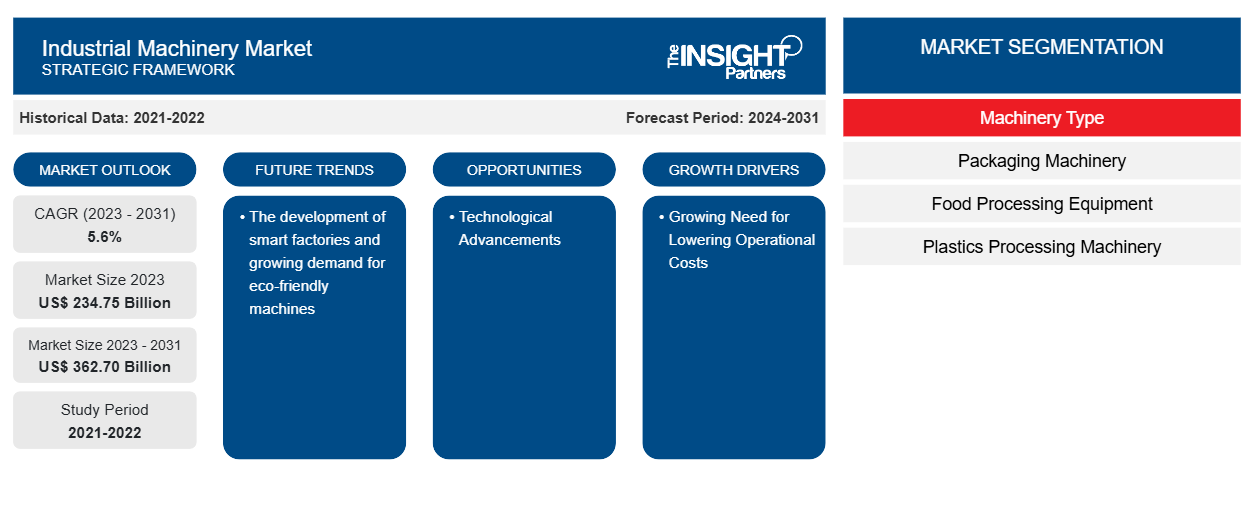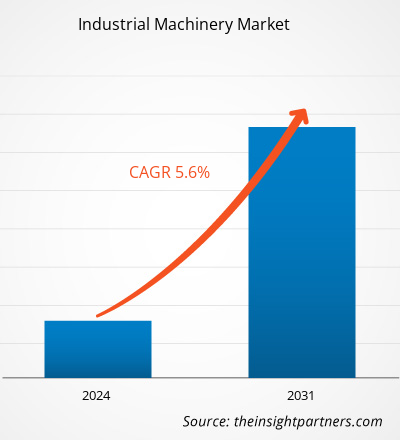Industrial Machinery Market Key Players and Opportunities by 2031
Historic Data: 2021-2022 | Base Year: 2023 | Forecast Period: 2024-2031Industrial Machinery Market Size and Forecast (2021 - 2031), Global and Regional Share, Trend, and Growth Opportunity Analysis Report Coverage: By Machinery Type (Packaging Machinery, Food Processing Equipment, Plastics Processing Machinery, Metal Forming Machine Tools, and Woodworking Machinery), and Geography
- Report Date : Mar 2026
- Report Code : TIPRE00010679
- Category : Electronics and Semiconductor
- Status : Data Released
- Available Report Formats :


- No. of Pages : 150
The industrial machinery market size is projected to reach US$ 362.70 billion by 2031 from US$ 234.75 billion in 2023. The market is expected to register a CAGR of 5.6% in 2023–2031. The development of smart factories and growing demand for eco-friendly machines is likely to remain a key industrial machinery market trend.
Industrial Machinery Market Analysis
The industrial machinery market is growing at a rapid pace due to the growing need for lowering operational costs and the increasing adoption of industrial machinery from automotive, food & beverages, pharmaceutical, manufacturing, and other industries. The market is expanding steadily, driven by the growing urbanization & industrial automation. Moreover, technological advancements and the integration of AI and 3D digital printing technology are providing lucrative opportunities for market growth.
Industrial Machinery Market Overview
Industrial machinery refers to any mechanical, electrical, or electronic equipment that is designed and used to perform a given function and produce a specific result. Manufacturers in manufacturing plants use these machinery for cutting, shaping, forming, laminating, or coordinating production processes. Industrial machinery plays a crucial in supporting industrial activities worldwide. The growing digitalization, technological advancements, and Industry 4.0 initiatives are creating opportunities in the market.
Customize This Report To Suit Your Requirement
You will get customization on any report - free of charge - including parts of this report, or country-level analysis, Excel Data pack, as well as avail great offers and discounts for start-ups & universities
Industrial Machinery Market: Strategic Insights

-
Get Top Key Market Trends of this report.This FREE sample will include data analysis, ranging from market trends to estimates and forecasts.
Industrial Machinery Market Drivers and Opportunities
Growing Need for Lowering Operational Costs is Driving the Market
Lower operating costs lead to higher margins, allowing businesses to diversify their product offerings and access new markets by making cost-cutting initiatives. The growing need among businesses to lower operational costs, increases the demand for technologically advanced machinery. Manufacturers are integrating IoT applications into these devices to provide enhanced services such as remote monitoring, central feedback systems, and other features. Moreover, manufacturers are also adopting enhanced sensors, mobile apps, and embedded software to streamline their operational processes by lowering the overall business costs is driving the market.
Technological Advancements – An Opportunity in the Industrial Machinery Market
Rapid technological advancements are expected to drive innovation in industrial machinery market during the forecast period. Furthermore, manufacturing industries are adopting advanced technologies such as artificial intelligence, 3D printing, and big data analytics to reduce operational costs, improve productivity, and gain higher profits. However, the potential integration of 3D printing and AI technology is creating growth opportunities for both international and domestic players present in the industrial machinery market.
Industrial Machinery Market Report Segmentation Analysis
Key segments that contributed to the derivation of the industrial machinery market analysis are machinery type.
- Based on machinery type, the industrial machinery market is divided into packaging machinery, food processing equipment, plastics processing machinery, metal forming machine tools, woodworking machinery.
- The packaging machinery segment is sub-segmented into filling machines, palletizing machines, labelling machines, wrapping machines, and others. The food processing equipment segment is sub-segmented into slicers and dicers, extruding equipment, depositors and mixers, storage and refrigeration equipment, and others. The plastics processing machinery segment is sub-segmented into inspection molding machines, blow molding machines, extrusion molding machines, and others. The metal forming machine tools segment is sub-segmented pressure machine, bending machine, casting machine, punching machine, and others. The woodworking machinery segment is sub-segmented lathes machine, grinding machine, bandsaw machine, and others.
Industrial Machinery Market Share Analysis by Geography
The geographic scope of the industrial machinery market report is mainly divided into five regions: North America, Asia Pacific, Europe, Middle East & Africa, and South America/South & Central America.
In terms of revenue, Asia Pacific accounted for the largest industrial machinery market share, due to the rising investment in infrastructure projects such as transportation, energy, and urban development. The growing need for a variety of industrial equipment, such as construction machinery, earthmoving equipment, and material handling equipment, is fueling the market in the region.
Industrial Machinery Market Regional InsightsThe regional trends and factors influencing the Industrial Machinery Market throughout the forecast period have been thoroughly explained by the analysts at The Insight Partners. This section also discusses Industrial Machinery Market segments and geography across North America, Europe, Asia Pacific, Middle East and Africa, and South and Central America.
Industrial Machinery Market Report Scope
| Report Attribute | Details |
|---|---|
| Market size in 2023 | US$ 234.75 Billion |
| Market Size by 2031 | US$ 362.70 Billion |
| Global CAGR (2023 - 2031) | 5.6% |
| Historical Data | 2021-2022 |
| Forecast period | 2024-2031 |
| Segments Covered |
By Machinery Type
|
| Regions and Countries Covered |
North America
|
| Market leaders and key company profiles |
|
Industrial Machinery Market Players Density: Understanding Its Impact on Business Dynamics
The Industrial Machinery Market is growing rapidly, driven by increasing end-user demand due to factors such as evolving consumer preferences, technological advancements, and greater awareness of the product's benefits. As demand rises, businesses are expanding their offerings, innovating to meet consumer needs, and capitalizing on emerging trends, which further fuels market growth.

- Get the Industrial Machinery Market top key players overview
Industrial Machinery Market News and Recent Developments
The industrial machinery market is evaluated by gathering qualitative and quantitative data post primary and secondary research, which includes important corporate publications, association data, and databases. The following is a list of developments in the market for industrial machinery and strategies:
- In November 2022, Ingersoll Rand launched 135MAX Heavy Duty Air Hammer for industrial uses. The 135MAX HD Air Hammer is the next-generation air hammer that builds on the foundation set by 119MAX to offer incredible performance and power at an accessible cost––while leveraging a fine-tuned feather-able trigger inspired by legendary Ingersoll Rand impact wrenches for more precision and even better results. (Source: Ingersoll Rand, Press Release, 2022)
Industrial Machinery Market Report Coverage and Deliverables
The “Industrial Machinery Market Size and Forecast (2021–2031)” report provides a detailed analysis of the market covering below areas:
- Market size and forecast at global, regional, and country levels for all the key market segments covered under the scope
- Market dynamics such as drivers, restraints, and key opportunities
- Key future trends
- Detailed PEST/Porter’s Five Forces and SWOT analysis
- Global and regional market analysis covering key market trends, major players, regulations, and recent market developments
- Industry landscape and competition analysis covering market concentration, heat map analysis, prominent players, and recent developments
- Detailed company profiles
Frequently Asked Questions
What is the estimated market size for the global industrial machinery market in 2023?
What are the driving factors impacting the global industrial machinery market?
What are the future trends of the global industrial machinery market?
Which are the key players holding the major market share of the global industrial machinery market?
The key players holding majority shares in the global industrial machinery market are AB Electrolux, Alfa Laval, AMADA CO., LTD., GEA Group, and HAITIAN INTERNATIONAL.
What will be the market size of the global industrial machinery market by 2031?
What is the incremental growth of the global industrial machinery market during the forecast period?
Naveen is an experienced market research and consulting professional with over 9 years of expertise across custom, syndicated, and consulting projects. Currently serving as Associate Vice President, he has successfully managed stakeholders across the project value chain and has authored over 100 research reports and 30+ consulting assignments. His work spans across industrial and government projects, contributing significantly to client success and data-driven decision-making.
Naveen holds an Engineering degree in Electronics & Communication from VTU, Karnataka, and an MBA in Marketing & Operations from Manipal University. He has been an active IEEE member for 9 years, participating in conferences, technical symposiums, and volunteering at both section and regional levels. Prior to his current role, he worked as an Associate Strategic Consultant at IndustryARC and as an Industrial Server Consultant at Hewlett Packard (HP Global).
- Historical Analysis (2 Years), Base Year, Forecast (7 Years) with CAGR
- PEST and SWOT Analysis
- Market Size Value / Volume - Global, Regional, Country
- Industry and Competitive Landscape
- Excel Dataset
Recent Reports
Testimonials
The Insight Partners' SCADA System Market report is comprehensive, with valuable insights on current trends and future forecasts. The team was highly professional, responsive, and supportive throughout. We are very satisfied and highly recommend their services.
RAN KEDEM Partner, Reali Technologies LTDsI requested a report on a very specific software market and the team produced the report in a few days. The information was very relevant and well presented. I then requested some changes and additions to the report. The team was again very responsive and I got the final report in less than a week.
JEAN-HERVE JENN Chairman, Future AnalyticaWe worked with The Insight Partners for an important market study and forecast. They gave us clear insights into opportunities and risks, which helped shape our plans. Their research was easy to use and based on solid data. It helped us make smart, confident decisions. We highly recommend them.
PIYUSH NAGPAL Sr. Vice President, High Beam GlobalThe Insight Partners delivered insightful, well-structured market research with strong domain expertise. Their team was professional and responsive throughout. The user-friendly website made accessing industry reports seamless. We highly recommend them for reliable, high-quality research services
YUKIHIKO ADACHI CEO, Deep Blue, LLC.This is the first time I have purchased a market report from The Insight Partners.While I was unsure at first, I visited their web site and felt more comfortable to take the risk and purchase a market report.I am completely satisfied with the quality of the report and customer service. I had several questions and comments with the initial report, but after a couple of dialogs over email with their analyst I believe I have a report that I can use as input to our strategic planning process.Thank you so much for taking the extra time and making this a positive experience.I will definitely recommend your service to others and you will be my first call when we need further market data.
JOHN SUZUKI President and Chief Executive Officer, Board Director, BK TechnologiesI wish to appreciate your support and the professionalism you displayed in the course of attending to my request for information regarding to infectious disease IVD market in Nigeria. I appreciate your patience, your guidance, and the fact that you were willing to offer a discount, which eventually made it possible for us to close a deal. I look forward to engaging The Insight Partners in the future, all thanks to the impression you have created in me as a result of this first encounter.
DR CHIJIOKE ONYIA MANAGING DIRECTOR, PineCrest Healthcare Ltd.Reason to Buy
- Informed Decision-Making
- Understanding Market Dynamics
- Competitive Analysis
- Identifying Emerging Markets
- Customer Insights
- Market Forecasts
- Risk Mitigation
- Boosting Operational Efficiency
- Strategic Planning
- Investment Justification
- Tracking Industry Innovations
- Aligning with Regulatory Trends




















 Get Free Sample For
Get Free Sample For